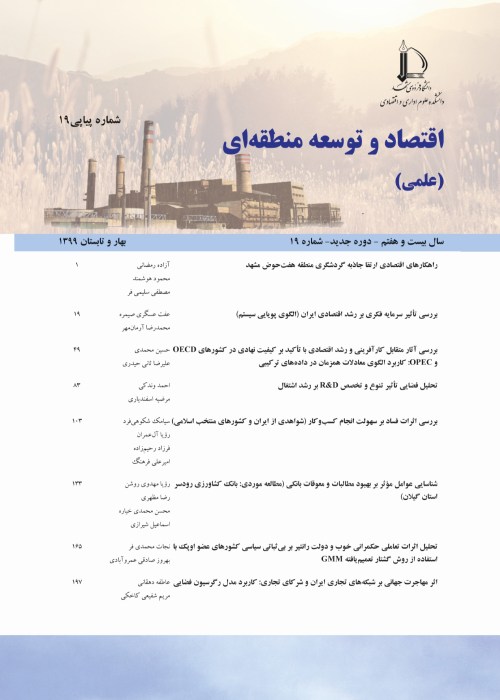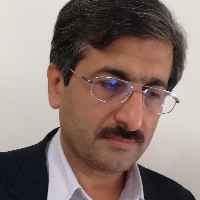Article Title: The Analysis of the Spatial Structure of Industrial Activities in Iran's Economy
Author(s):
Article Type:
Research/Original Article (دارای رتبه معتبر)
Abstract:
The main purpose of this study is the spatial investigation of the industrial structure among Irans provinces and the matters that can effect this formed structure. In fact, the underlying spatial structure of industry which shapes the economy is the result of the spatial dependence on the different parts of that economy due to which the centripetal and centrifugal forces come to existence. This study analyses the spatial structure of industry in the Iranian economy. Therefore, the vital questions raising here are how is the spatial structure of the industrial activities in this economy? Whether or not this structure associates with the spatial inequality? What factors cause the formation of such structure in the present industry? And eventually, knowing whether spatial dependence on different provinces of Iran, could be an important channel to construct this structure. These various issues are addressed in this study. Geographers and economists alike have sought to develop indices that capture inequality across industries, time, and space. In the first section, we present the ideal index of spatial concentration i.e., Ellison and Glaeser index (1997). This will allow us to find out how spatial inequalities imply new and specific constraints. Then, the approach that consists of regressing industry-specific indices of spatial concentration on a number of explanatory variables suggested by theoretical models, such as the intensity of increasing returns, the level of trade costs, or the market potential is considered.
Methodology
In order to answer the questions of this study, Ellison and Glaeser (1997) concentration index has been used to evaluate the industrial spatial structure between the provinces of Iran. As this measurement has been done within the period of 1997-2013 and is based on the two-digit industries (ISIC classified), the effective factors forming the structure of industrial activities which have estimated the spatial econometric model of the time should be identified. The analytical model used in this study is Spatial Autoregressive Panel Data model (SAR Panel Data). An important point is that in spatial regression models each observation corresponds to a location or region. In other words, this model could consider the dependence between the regions or sections. Spatial dependence reflects a situation where values observed at one location or region, say observation i, depends on the values of the neighboring observations at nearby locations. Spatial regression models exploit the complicated dependence structure between observations which represent countries, regions, counties, etc. As a result, the parameter estimates contain a wealth of information on the relationships among the observations or regions. A change in a single observation (region) associated with any given explanatory variable will affect the region itself (a direct impact) which can potentially affect all the other regions indirectly (an indirect impact). In fact, the ability of spatial regression models to capture these interactions represents an important aspect of spatial econometric. An implication of this is that a change in the explanatory variable for a single region (observation) can potentially affect the dependent variable in all other observations (regions). This is of course a logical consequence of our SDM model, since the model takes into account other dependent regions and the explanatory variables. This type of development has wide-ranging implications for the interface of economic theory and econometrics. It suggests that spatial econometric models may be applicable to many situations where they have not previously been employed.Results And Discussion
The results of EG indicator show that the spatial structure of industry in the economy is considerably unequal. Thus, based on this inequality, Azarbaijan sharghi, Qazvin, Markazi, and Tehran with values of .044, .051, .052 and .063 for spatial concentration index perspectively, are the most industrialized Provinces. In contrast, Bushehr, Hormozgan, and Ilam with values of .550, .244, and .317 are as the least developed provinces in the industry sector and have only certain industrial activities. In the next phase of the study, results of estimating spatial econometric model show that coefficients of market potential, return to scale, price per square meter of land in the province, and the transportation costs in spatial model, each one is estimated as -.174, -.041, -.023, and.038, respectively. In contrast, the coefficients of the variables of average wages and budget expenses of government is estimated with positive values. The estimation of the rate of dependence coefficient on provinces in spatial model (.430) shows that the centripetal forces in the provinces can dominate the centrifugal forces. In addition, due to existance of spatial dependence, we can identify extensive network of interdependences among provinces and their potentials impact on the structure of industry. Also, we can analyze the province's capacity to absorb changes in any of the mentioned factors that affect the structure. Results from the identified extensive network show that provinces of Tehran, Qom, and Qazvin have the highest coefficient of effectiveness and the highest ability to absorb the changes generated in the explanatory variable. Besides, Sistan and Baluchestan and Hormozgan provinces on average, have the lowest coefficient of effectiveness and the ability to absorb the changes generated in the explanatory variables.Keywords:
Language:
Persian
Published:
Journal of Economy and Regional Development, Volume:24 Issue: 14, 2018
Pages:
1 to 28
magiran.com/p1837519
دانلود و مطالعه متن این مقاله با یکی از روشهای زیر امکان پذیر است:
اشتراک شخصی
با عضویت و پرداخت آنلاین حق اشتراک یکساله به مبلغ 1,390,000ريال میتوانید 70 عنوان مطلب دانلود کنید!
اشتراک سازمانی
به کتابخانه دانشگاه یا محل کار خود پیشنهاد کنید تا اشتراک سازمانی این پایگاه را برای دسترسی نامحدود همه کاربران به متن مطالب تهیه نمایند!
توجه!
- حق عضویت دریافتی صرف حمایت از نشریات عضو و نگهداری، تکمیل و توسعه مگیران میشود.
- پرداخت حق اشتراک و دانلود مقالات اجازه بازنشر آن در سایر رسانههای چاپی و دیجیتال را به کاربر نمیدهد.
In order to view content subscription is required
Personal subscription
Subscribe magiran.com for 70 € euros via PayPal and download 70 articles during a year.
Organization subscription
Please contact us to subscribe your university or library for unlimited access!



